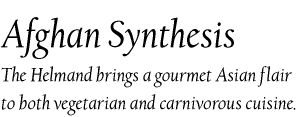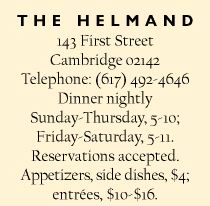Main Menu · Search · Current Issue · Contact · Archives · Centennial · Letters to the Editor · FAQs

| Directions in Wellness | Healthcare Directory | |
| Retirement Directory | Afghan Synthesis: The Helmand | |
| Tastes of the Town Dining Guide | Calendar: The Harvard Scene | |
| The Sports Scene | ||

|
Every year, gourmet vegetarian cuisine seems to reach new heights. Partial or total vegetarians comprise a steadily growing segment of the population. Younger age groups like Harvard undergraduates include sizable numbers who eschew, rather than chew, meat; executive chef Mike Miller of Harvard Dining Services estimates that about 15 percent of the College's students are vegetarians, and his kitchens offer them a plant-kingdom option at each meal.
Yet the proportion of vegetarians in the wider population is much smaller, and, consequently, superb vegetarian restaurants are few and far between. But the burgeoning array of ethnic restaurants in this country provides an increasingly popular alternative for those who prefer their animals in the living state. These bistros often elaborate their dishes from Asian, Mideastern, African, South American, and Micronesian peasant recipes. Throughout history, peasant diets have been predominantly vegetarian--especially when compared with aristocratic fare.
At an Afghan restaurant like The Helmand in East Cambridge, the diner can straddle both ends of the spectrum, choosing from a multitude of vegetarian entrées that are complex, refined, and delicious enough to please any aristocrat. Make no mistake--Helmand's 18 main dishes of beef, lamb, and chicken (especially lamb) form the meaty core of its menu. But eight vegetarian entrées and four appetizers offer fresh, scintillating flavors and textures that might bliss out even the most confirmed carnivore.

As geography suggests, Afghan food mingles elements of Middle Eastern and Indian cooking, synthesizing them into a delightfully tasty repertoire. Take an appetizer like kaddo, made from baby pumpkin that is pan-fried, then baked, puréed, and served with yogurt garlic mint sauce. Garlic's strong bite contrasts with, and so amplifies, the delicate sweetness of the pumpkin. Aushak, Afghan ravioli, counterpoints its smooth leek-paste filling with a yellow split-pea and carrot sauce, a variant of Indian dahl. Yogurt mint sauce accompanies appetizers about as often as one might expect in, say, Beirut.
A specialty entrée like dolma contains pleasing variety: eggplant stuffed with spinach, then sautéed with cauliflower, red and green peppers, corn, and green peas in a sauce of onions, tomatoes, and spices. The kitchen does not cook its vegetables into submission, thus preserving the jostling contrasts of textures along with those of tastes. On the meatier side, consider chowpan, half a rack of lamb marinated and then grilled to exquisite, falling-off-the-bones tenderness, served on a bed of Afghan bread and sautéed eggplant and rice.
Afghan flatbread, soft and light on the bottom and brown on the top, is the best flatbread I've tasted. It emerges very fresh from a special oven in the wall of the main dining room. Reminiscent of Indian flatbreads like nan, its crispy texture and buttery flavor leave pita bread in the Mideastern dust.
The setting at The Helmand is agreeable, if not as consistently bewitching as the food. The front dining room is airy, with a high ceiling, bright, somewhat loud acoustics, and sunflower-colored walls. Ethnic artifacts like hats and a samovar decorate the mantelpiece of a small fireplace, where a fire burns in cold weather. The service, from a multicultural staff, is polite and friendly, if not overly swift; our appetizers took 15 minutes to arrive (admittedly, we were seated at 8 p.m. on a busy Friday evening). Expect your tab to be $70 to $80 for two, including tip and a bottle of wine.
The Helmand's namesake is a famous river in Afghanistan, over which the Afghans once battled Iran. For a meatless night out--or any other kind--consider it a river of culinary pleasure.
~ C.L.
Main Menu ·
Search · Current Issue · Contact · Archives · Centennial · Letters to the Editor · FAQs
![]()